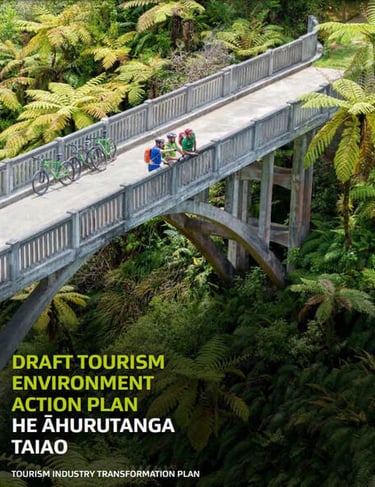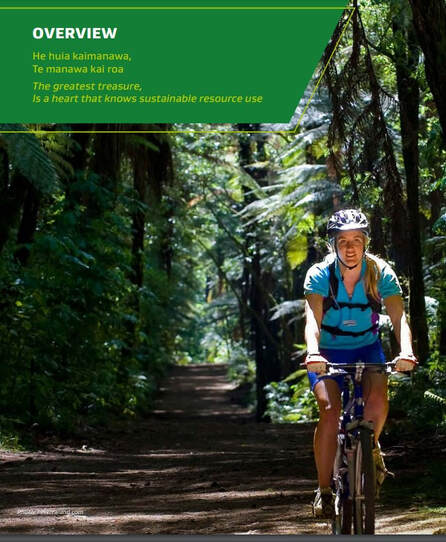Trains: The backbone of a low emission tourism industry
Reviving passenger rail has to be a key strategy of the tourism industry to give it any hope of becoming a truly regenerative model.
CLIMATE CHANGETOURISM
Paul Callister
4 min read


Consultation on the Draft Tourism Environment Action Plan 2023 has just closed. Save Our Trains put in a submission.
As cited in the draft Tourism Strategy, the Decarbonising Transport Action Plan 2022-2025, released in December 2022 notes, “transport is one of our largest sources of emissions and we have a goal to reduce [domestic] transport emission by 41% by 2035. Currently international aviation and shipping emissions are outside these targets. However, others have argued that we need more ambitious transport decarbonisation goals. 1Point5 Project research suggests mitigating the risk of a delay in the decarbonisation of farming requires transport to aim for almost full decarbonisation by 2030. I agree with this assessment.
First, some background about the draft report. The report was overseen by the Tourism Environment Leadership Group. This included industry representatives, unions and, potentially speaking up for the environment, Forest & Bird and the Department of Conservation. Aviation interests were overrepresented. Some land transport interests were also represented, in the form of car hire and campervan hire companies. Missing were the voices of the two lowest emission land transport operators, KiwiRail and InterCity. The ability for trains to reduce emissions – and provide a high quality, enjoyable way to travel - has been set out in several of our blogs.
As further background, the Department of Conservation has a partnership with Air New Zealand. Forest & Bird, at its national conference has a session called “Courageous Leadership in the time of the Climate & Biodiversity Crises”, has a speaker from Air New Zealand but no one representing low emission passenger rail.
There were no sustainable travel experts from academia or climate change on the Tourism Environment Leadership Group. Trains, as the potential backbone of sustainable tourism travel, were on a back foot right from the start.
There is another issue that potentially divides train enthusiasts. That is what overall level of international tourism is sustainable? Some see international tourists as a vital income earner and an important market for domestic train travel. But in a climate emergency, should we be marketing New Zealand to the world, flying people long distances to New Zealand knowing aviation has no realistic short- or medium-term decarbonisation plan? Research carried out with my colleague Robert McLauchlan suggests that we should pause growth and, ideally, cut back levels of international arrivals until the industry can demonstrate that it can substantially cut emissions. Bringing international aviation and shipping into our carbon budgets will bring more focus to this issue.
Whatever the level of tourism, in almost all industrialised countries, these travellers arriving at major airports will have the option of journeying into the nearby city by light or heavy rail. Especially in Europe, a key international tourism destination, travellers then have the option of travelling regionally and inter-regionally by fast and not so fast rail. In New Zealand, most tourists turn to hired cars, camper vans or, the budget conscious, buying a second-hand car to travel around. If we are to reduce emissions this has to change.
Equally, New Zealand families have little ability to use good quality affordable and frequent rail to reach main tourism centres. For example, they can no longer travel to tourist town Rotorua by train. It is impossible to organise a weekend visit to Ruapehu from either Auckland or Wellington by train to go mountain biking. Or a beach holiday at Mt Maunganui by train.
As we well know, Aotearoa New Zealand only retains a mere skeleton long distance passenger rail service. The day train service between Auckland and Wellington is infrequent, expensive and only has limited stops. It is aimed at a small group of high-end tourists and is not affordable for most New Zealand families going on holiday, also an important part of tourism.
Unlike most industrialised countries, there are no night trains operating in New Zealand. These are important tourism services in Europe.
With the bias in the Tourism Environment Leadership Group, it is not surprising, but nevertheless disappointing, that the draft tourism strategy repeats myths about rail.
On page 44 it states “[c]ompared to other countries, tourism transport between destinations in Aotearoa New Zealand depends on aviation to a greater extent, due to the distances and complex geography between our major cities.”
Save Our Trains/The Future Is Rail member Suraya Sidhu Singh tackles these myths.
There are many examples of countries that have very challenging geography but also have well developed rail systems. An example is Switzerland, a very popular European tourist destination. Others are Japan and Norway. While it has a larger population than New Zealand (just under 9 million people), Switzerland has a fully electrified rail network with 92% of electricity from renewable sources, and just under 800 passenger train stations.
New Zealand has few operating railway stations, many very run-down. Wellington station has no heated waiting room, no showers, and no dedicated parents’ room. Given Wellington station caters for the few remaining longer distance passenger services, as well as InterCity coaches, its facilities are substandard and would not be accepted in an airport.
Longer distance passenger trains throughout New Zealand could cater for a range of tourists. This includes those using bikes. Many North Island bike trails begin near current and former stations. But current trains are not well set up to carry bikes. We discuss this on another of our blogs.
Cycle tourism could really increase and improve options for local people at the same time. Ideally, we would make both cycling and walking pleasant with appropriate and safe infrastructure. Together, these would go a long way to creating nicer places. Our countryside, towns, and cities, linked by trains, would become lovely places to visit, if we reduced how much the car dominates them, to make them safe to walk and cycle.
Reviving passenger rail has to be a key strategy of the tourism industry to give it any hope of becoming a truly regenerative model.
Cyclists on this route could arrive at Ohakune by train and finish at Whanganui to catch a train home - if we revitalised our rail network. Image: MBIE


Cyclists on the Timber Trail could arrive by train at the currently abandoned Ongarue station. Image: MBIE
